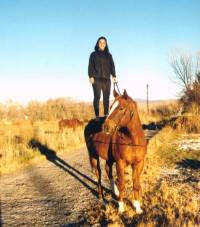 Got a spooking horse?
Got a spooking horse? Well, for every way that your horse can find to spook, there is a cowboy way to fix that spooking horse ... and some of them are downright scary.
The milder versions, which involve sacking out the horse with a burlap bag, often work just fine. It's the wilder versions that involve tying a horse under a set of train tracks for a day that scare me. These methods can be dangerous or life-threatening to the horse.
And then there's the spooking horse that you literally can't calm down by using desensitizing techniques. Which horse is that?
The Shao Yang personality type horse.
Forget trying to de-spook a horse of this personality (learn more about horse personalities here). Trust me. I have a Shao Yang, a lovely mare named Sammie Joe (that's her picture). My neighbor has a Shao Yang mare, too. De-spooking doesn't work.
Why You Can't Sack Out the Shao Yang Spooking Horse
Shao Yang horses are, according to the horse personality typing system developed by Dr. Madalyn Ward, a combination of Fire and Wood. The Fire aspect of this horse personality type makes this horse sensitive, flashy, and demanding of their human. The Wood part of this horse is competitive, athletic, and often bossy. Put the Fire and the Wood together and you get a horse who often spooks or jumps at the most unexpected moments.
And you can't "fix" this spooking horse with any of the traditional methods because they won't work. For instance, when I first adopted Sammie Joe, a mustang mare, she was spooky as heck. I tried sacking her out, which took a couple hours per session. The next day, I'd go to check the results of the previous day's session, only to discover that it was a whole new day for Sammie Joe. She reacted as if she had never seen the sack before. This happened over and over and over again.
Lesson learned: Every day is a new day for a spooky Shao Yang horse.
My neighbor's mare is the same way. She spooks at the RoboSteer we use for practice in our roping clinics. At the end of the day, she will accept the RoboSteer, but the next day she'll act as if she's never seen it before. Then she goes into the same spooking horse routine as the day before.
How to Deal with a Shao Yang Spooking Horse
The one and only way I have found to channel all that spooky energy, since sacking out doesn't really work, is to give the Shao Yang a job she likes. For Sammie Joe, that job is jumping. Put her in an arena filled with jumps and she stops spooking.
During warm up, she might still spook at all kinds of things, but when she is in the arena by herself, during the actual competition, she's all business. When I ride her in a jumper class, I feel like I'm riding a guided rocket. She'll wait for me to point her to a jump, then she literally "locks on" and starts counting strides to the jump ... and her math is NEVER wrong. She likes to do a challenging job (the Wood part of her personality), and she likes to do it perfectly (the Fire part of her personality). She never touches a single jump with her feet and she never meets a fence wrong. And she never spooks.
The same is true of my neighbor's mare. On the RoboSteer, she's spooky as heck, but put her on a live steer and all of sudden she can focus. She doesn't spook or jig. She goes for the steer. The Wood part of her personality, which really likes to push and chase things, steps up and she suddenly does her job without spooking.
Do You Have a Shao Yang Horse?
If you have a spooking horse you just can't desensitize, chances are that you have a Shao Yang horse. Some other characteristics of Shao Yang horses include:
- extreme athleticism
- tough feet when healthy
- strong opinions
- more likely to run than buck when troubled
- love of speed
If you're not sure what your horse's personality type is, check out these horse personality testing resources:
Horse Harmony Website
Horse Harmony Test
Horse Harmony Audios
If you enjoyed this post, please consider leaving a comment or subscribing to the feed to have future articles delivered to your feed reader. Also, check out my ebook for wacky horses and humans, or holler at me if you want to know how I fund my horse addiction ... and you can, too!
Photo credit: Barb Young Photography








